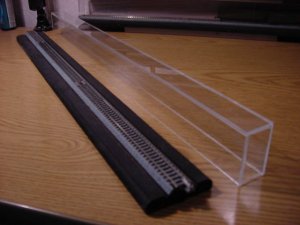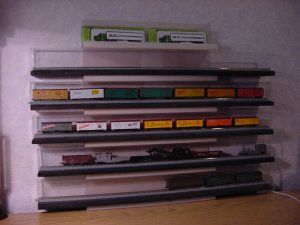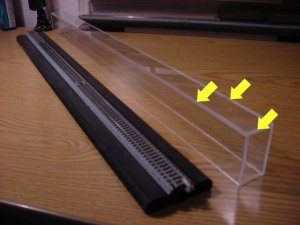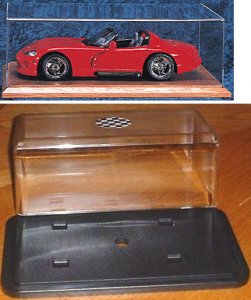Steve, as to the thickness, it was the thinnest and cheapest stuff I found at Home Depot. My vernier reads .090", fractional size ????
Andy I came to the same conclusion after a local plastic supplier and distributor told me what was involved for a special order. Seems to me that there is a market out there for clear rectangular shaped plastic tubes. Had to experiment some with the sheets I bought at the "Orange Box". Scoring and breaking the sheet in widths of 1- 1/4" and 2" proved difficult. Solved that problem by kerfing a piece of 2 x 4 with my radial arm saw. By inserting the plastic edge, the entire length of it into the 2 x 4, it allowed me to snap the plastic on the scored line each and every time. I used one of the heavy duty tools they sell for scoring the plastic. The biggest key incredient is the liquid solvent for bonding the acrylic pieces. The stuff I used I purchased from a plastic distributor and is made just for bonding acrylics. "Weld-on" the #4 formula for moderately fast curing. You assemble the pieces, top and sides with clamps, (tape will not work), standing the parts on end, carefully add drops of the solvent to each seam. Add just enough to each seam so that you see the liquid travell down to the other end of your work. Does a great job, but takes a little practice. I tried all the other plastic adhesives and glues, always made a mess and the seam was not as tranlucient as I wanted. Found also that if I used tape to hold the parts together, the liquid solvent ran under the tape and created a sticky mess. The edges of the work are best worked by scraping it with a razor blade. Sanding leaves an unsightly dull edge, but, that can be scraped down with a razor to get that polished look.
The base is made from 1/2" MDF particle board with two and a half sections of the "Kato" sectional track glued to it. Again my original goal was to make cassette type cases for pluging into a staging area. That flopped because the cars would not stay on the track with handling. Oh well, the ten cases look great stationary on my wall. It was very labor intensive but all things considered it was a learning experience.






